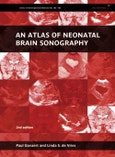Readership
Neonatologists, radiologists, neuroradiologists with an interest in neonatal ultrasound
From reviews of the first edition:
"This is the most challenging and comprehensive book on this theme, and is an essential reference for clinicians to make a correct diagnosis."
- Satoshi Takada, Brain and Development
"This can be little doubt that this title represents the definitive work on neonatal cranial ultrasound. The authors have had extensive experience in the use of ultrasound scanning the neonatal brain for almost as long as ultrasound has been used to investigate intracranial pathology on the neonatal unit. Their combined experience is most impressive."
- Malcolm Leven, Archives of Disease in Childhood
Table of Contents
SECTION 1. NORMAL ANATOMY
1.1 Sulci and gyri
1.2 Lateral ventricles
1.3 Third ventricle
1.4 Choroid plexus
1.5 Lobar parenchyma
1.6 Midline structures
1.7 Cisterns
1.8 Basal ganglia and thalamus
1.9 Brainstem
1.10 Cerebellum
1.11 General references on normal anatomy
SECTION 2. CONGENITAL ANOMALIES
2.1 Disorders of neurulation
2.2 Cephalocele
2.3 Hydrocephalus
2.4 Intracranial fluid collections
2.5 Unilateral hydrocephalus
2.6 External hydrocephalus
2.7 Disorders of the corpus callosum
2.8 Septal agenesis and malformation
2.9 Hamartoma and accessory brain
2.10 Cerebral hemiatrophy
2.11 Microcephaly
2.12 Schizencephaly
2.13 Disorders of neuroblast migration
2.14 Median prosencephalic dysgenesis – holoprosencephaly
2.15 Posterior fossa anomalies
2.16 Vascular anomalies
SECTION 3. ANTENATAL BRAIN DAMAGE
3.1 Antenatal intracranial haemorrhage
3.2 Global forebrain ischaemia before birth
3.3 Germinolysis
3.4 Hydranencephaly
3.5 Porencephaly
3.6 Multicystic encephalopathy
3.7 Choroid plexus pseudocyst
3.8 Moebius sequence
3.9 Twin-associated antepartum brain damage
3.10 Striatal vasculopathy
3.11 Fetopath
SECTION 4. HAEMORRHAGE
4.1 GMH/IVH
4.2 posthaemorrhagic ventricular dilatation
4.3 Epidural haematoma
4.4 Subdural haematoma
4.5 Lobar cerebral haemorrhage
4.6 Cerebellar haemorrhage
4.7 Bleeding into thalamus, basal ganglia and ventricle
4.8 Term IVH
4.9 Subarachnoid haematoma and non-accidental injury
SECTION 5. ASPHYXIA
5.1 Causes and clinical types of asphyxia
5.2 Neuropathological paradigms
5.3 Myelination
5.4 Maturation of sonographic changes
5.5 Brain swelling
5.6 Haemorrhage in areas of selective neuronal necrosis
5.7 Parasagittal cerebral injury
5.8 Leukomalacia
5.9 Selective neuronal necrosis to cortex, deep grey matter and hindbrain
5.10 Primary cortical injury
5.11 Focal infarction with asphyxia
5.12 Cerebral blood flow velocity
5.13 Combinations of paradigms
5.14 Scoring the gradation of injury
SECTION 6. ISCHAEMIC STROKE
6.1 Arterial
6.2 Venous sinus
SECTION 7. PRETERM WHITE-MATTER INJURY
7.1 Pathogenesis
7.2 Neuropathology
7.3 Venous infarction
7.4 Risk factors
7.5 Timing
7.6 Imaging aspects
7.7 New approach
SECTION 8 MISCELLANEOUS
8.1 Kernicterus
8.2 Hypoglycaemia
8.3 Hyperglycaemia
8.4 Inborn errors of metabolism
8.5 Reversible encephalopathy
8.6 Bacterial meningitis, ventriculitis
8.7 Air embolism
8.8 Craniocerebral erosion
8.10 Brain perforation
8.11 Neuroectodermal disorders
8.12 Leukodystrophy
8.13 Tumour








